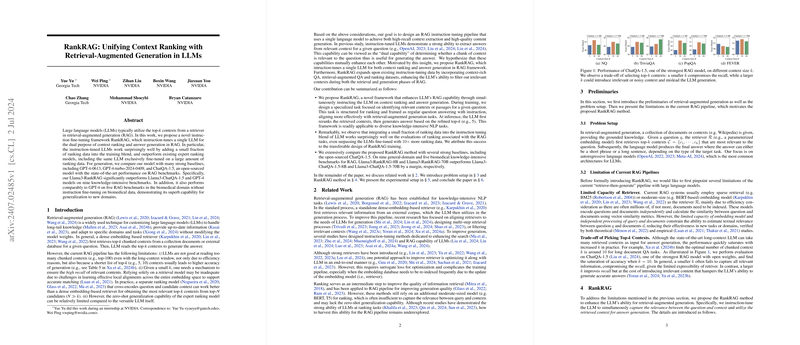RankRAG: Unifying Context Ranking with Retrieval-Augmented Generation in LLMs
Introduction
The paper "RankRAG: Unifying Context Ranking with Retrieval-Augmented Generation in LLMs" addresses a critical challenge in the domain of retrieval-augmented generation (RAG) with LLMs. Traditional RAG techniques rely on a retriever to fetch the top-k contexts for question answering, where k is typically small due to efficiency and accuracy concerns. However, this approach encounters several limitations, such as the inability of LLMs to efficiently process numerous chunked contexts and the intrinsic limitations of existing retrievers in learning effective local alignments across large embedding spaces. The RankRAG framework proposed in this paper aims to overcome these issues by instruction fine-tuning a single LLM for both context ranking and answer generation in RAG scenarios.
Key Contributions
The paper presents several notable contributions to the field:
- Unified Instruction-Tuning Framework: The core innovation of RankRAG is the unified instruction-tuning framework that enables a single LLM to perform both context ranking and answer generation. This is achieved by incorporating a small fraction of ranking data into the instruction-tuning blend, significantly enhancing the LLM's capability to identify relevant contexts and generate accurate answers.
- Effective Data Integration: RankRAG integrates context-rich question-answer datasets, retrieval-augmented QA, and ranking datasets. This enhances the LLM's ability to filter out irrelevant contexts during both the retrieval and generation phases of RAG.
- Empirical Superiority: The RankRAG model, particularly in its Llama3-RankRAG variants, outperforms several strong baselines, including high-performing models like GPT-4 and GPT-4-turbo, on various benchmarks. Additionally, it shows superb generalization capabilities to new domains, such as the biomedical field, even without instruction fine-tuning on domain-specific data.
Experimental Evaluation
Setup
The experimental setup involves evaluating RankRAG on nine knowledge-intensive benchmarks, including:
- Open-domain QA: NQ, TriviaQA, PopQA, HotpotQA, 2WikimQA
- Fact Verification: FEVER
- Conversational QA: Doc2Dial, TopiOCQA, INSCIT
Results and Analysis
Performance on General-Domain Tasks: RankRAG consistently surpassed strong baselines across various QA tasks. For example, Llama3-RankRAG-8B significantly outperformed Llama3-ChatQA-1.5-8B and GPT-4 models on datasets like NQ and TriviaQA. This demonstrates the effectiveness of integrating context ranking within the instruction-tuning process.
Zero-Shot Generalization: Remarkably, RankRAG performed comparably to GPT-4 on biomedical domain tasks without specific fine-tuning on biomedical data. This aspect highlights its robust generalization capability and practical utility in diverse application domains.
Implications and Future Directions
The implications of this research are profound for both the practical deployment and theoretical understanding of RAG systems:
- Enhanced Practical Utility: By unifying context ranking with answer generation, RankRAG eliminates the need for separate ranking models, simplifying the deployment pipeline and potentially reducing latency.
- Scalability and Efficiency: The demonstrated data efficiency in achieving superior performance with fewer ranking samples suggests that RankRAG can be scaled effectively for various large-scale real-world applications.
- Theoretical Insights: This paper underscores the mutual enhancement between context ranking and answer generation within an LLM. Further exploration into this synergy might offer deeper theoretical insights into optimizing multi-task instruction tuning.
Conclusion
RankRAG represents a significant advancement in the field of RAG techniques for LLMs. By successfully unifying context ranking with retrieval-augmented generation through instruction fine-tuning, it addresses several critical limitations of existing RAG pipelines. The empirical results validate its effectiveness and robustness across both general-domain and specialized tasks. Future work could explore finer-grained instruction-tuning strategies and further optimize the efficiency and scalability of the RankRAG framework, potentially expanding its applicability to even broader AI and NLP applications.
